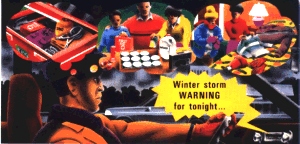 Are you ready for a Winter Storm?
Are you ready for a Winter Storm? Are you ready for a Winter Storm?
Are you ready for a Winter Storm? American Red Cross
American Red Cross Federal Emergency Management Agency
Federal Emergency Management Agency  National Oceanic and Atmospheric Administration
National Oceanic and Atmospheric Administration
Reprinted by Permission of the American Red Cross (1997)
Be sure you have properly operating smoke detectors and fire extinguishers.
Have extra blankets on hand.
Ensure that each member of your household has a warm coat, gloves, or mittens, hat, and water-resistant boots.
Assemble a disaster supplies kit containing:
First aid kit and essential medications
Battery-powered NOAA Weather Radio and portable radio, flashlight, and extra batteries
Canned food and non-electric can opener
Bottled water
Have your car winterized before winter storm season.
Assemble a disaster supplies kit for your car (see list below).
Listen to NOAA Weather Radio and your local radio and TV stations for updated storm information.
Know what winter storm WATCHES and WARNINGS mean:
A winter storm WATCH means a winter storm is possible in your area.
A winter storm WARNING means a winter storm is headed for your area.
A blizzard WARNING means strong winds, blind wind-driven snow, and dangerous wind chill are expected. Seek shelter immediately!
Listen to NOAA Weather Radio, local radio and TV stations, or cable TV such as The Weather Channel for further updates.
Be alert to changing weather conditions.
Avoid unnecessary travel.
Stay indoors during the storm.
If you must go outside, several layers of lightweight clothing will keep you warmer than a single heavy coat. Gloves (or mittens) and a hat will prevent loss of body heat. Cover your mouth to protect your lungs.
Understand the hazards of wind chill, which combines the cooling effect of wind and cold temperatures on exposed skin. As the wind increases, heat is carried away from a person’s body at an accelerated rate, driving down the body temperature.
Walk carefully on snowy, icy sidewalks.
After the storm, if you shovel snow, be extremely careful. It is physically strenuous work, so take frequent breaks, Avoid overexertion.
Have emergency supplies in the trunk (see list below).
Keep you car’s gas tank full for emergency use and to keep the fuel line from freezing.
Let someone know your destination, your route, and when you expect to arrive. If your car gets stuck along the way, help can be sent along your predetermined route.
Stay with your car. Do not try to walk to safety.
Tie a brightly colored cloth (preferably red) to the antenna for rescuers to see.
Start the car and use the heater for about 10 minutes every hour. Keep the exhaust pipe clear so fumes won’t back up into the car.
Leave the overhead light on when the engine is running so that you can be seen.
As you sit, keep moving your arms and legs to keep blood circulating and to stay warm.
Keep one window away from the blowing wind slightly open to let in air.
Winter storms bring ice, snow, cold temperatures, and often dangerous driving conditions. Even small amounts of snow and ice can cause severe problems for southern states where winter storms are infrequent.
Be prepared by having various household members do each of the items on the checklist below.
Put together a disaster supplies kit for your home in a clearly labeled, easy-to-grab box. Include a battery-powered NOAA Weather Radio and portable radio, flashlight, extra batteries, canned food and non-electric can opener, first aid supplies (including essential medications), and bottled water.
Location of disaster supplies kit:_____________________
Put together a separate disaster supplies kit for the trunk of each car used by members of your household. Include blankets, extra sets of dry clothing, a shovel, sand, tire chains, jumper cables, a first aid kit, a flashlight with extra batteries, and a brightly colored cloth to tie to the antenna.
Car emergency kit put together and placed in car(s):___________(date)
Winterize the car(s) before winter storm season.
Car(s) winterized:______________________(date)
Designate one household member as the winter storm preparedness leader. Have him or her discuss what to do if a winter storm watch or warning is issued. Have another household member state what he or she would do if caught outside or in a vehicle during a winter storm.
Household winter storm preparedness leader:___________________
Take an American Red Cross first aid course to learn how to treat exposure to the cold, frostbite, and hypothermia.
Household member(s) trained in first aid:______________________
Certifications good through:______________(date)
And remember...when a winter storm, tornado, earthquake, food, fire, or other emergency happens in your community, you can count on your local American Red Cross chapter to be there to help you and your loved ones. That’s been our role for more than 100 years.
For further information on winter storms, ask for Winter Storms... the Deceptive Killer from your local American Red Cross chapter, National Weather Service office, or emergency management office.
NOAA PA 91003
ARC4464
October 1991